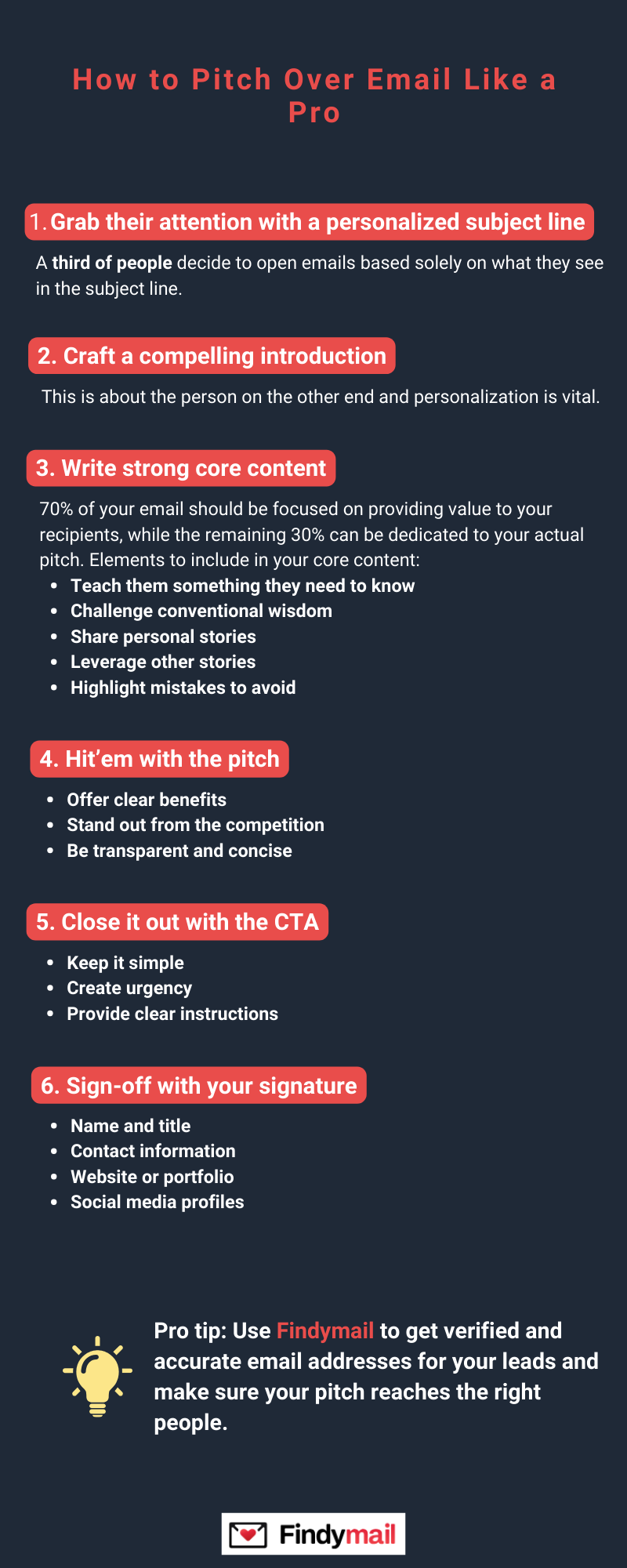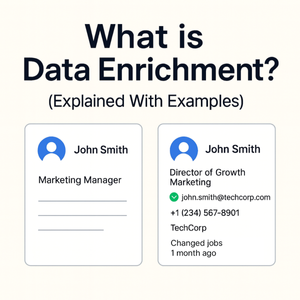Master the art of writing effective email pitches with our comprehensive guide covering proven strategies for crafting compelling messages, ultimate email pitch templates, and real-world examples.
Learn how to grab attention with engaging subject lines, avoid common mistakes, and create successful cold email pitches that generate positive responses.
This ultimate guide covers essential elements to include in your pitch email, proven strategies to grab attention with compelling subject lines, best email pitch templates and examples for different scenarios, common mistakes to avoid in email pitches, effective follow-up email strategies, and the difference between cold email pitches and warm outreach approaches.
Email marketing has a huge ROI, and it's no slouch when it comes to guiding prospects through your sales pipeline.
Writing an effective email pitch is essential for successful sales outreach, cold email campaigns, and business development.
There is a proviso to this: you need to craft compelling email pitches with strong value propositions that resonate with your recipients. If not, they won't be as effective, you'll get poor response rates, or even worse, your emails might be marked as spam.
So in this ultimate guide, I'll show you how to write effective email pitches that grab attention and get results!
What Should Be Included in a Pitch Email?
Before diving into the step-by-step process, let's understand the essential elements that should be included in every effective email pitch.
Every successful email pitch should include compelling subject lines that grab attention immediately, personalized introduction that establishes rapport with the recipient, clear value proposition that addresses specific needs, concise pitch content focused on benefits rather than features, strong call-to-action that guides the next step, and professional signature with complete contact details.
Understanding these core elements ensures your pitch email includes all necessary components to engage prospects and drive meaningful responses in your sales outreach efforts.
Step-by-Step Guide to Crafting an Email Sales Pitch
Step 1: Grab Their Attention with a Killer Subject Line
The subject line is undeniably one of the most crucial elements of your email pitch for grabbing attention.
It's the first thing recipients see, and it can determine whether your pitch email gets opened and read or swiftly sent to the trash bin.
In fact, did you know that a third of people decide to open emails based solely on what they see in the subject line?
That's why crafting engaging subject lines is essential for effective email pitches and successful cold email outreach.

The key to writing compelling subject lines for email pitches lies in personalization and clear value communication. Avoid spam trigger words and focus on creating curiosity while indicating specific benefits for the recipient.
Here are proven email pitch subject line examples that grab attention effectively:
- Hey [Name], Quick Question About [Specific Challenge]
- [Company]: Your Solution to [Specific Pain Point]
- Exclusive Offer Inside: [Benefit] Just for [Company Name]
- You're Invited: Join [Event] and [Specific Benefit]
- [Name], I Have an Idea That Could [Achieve Desired Outcome]
Remember, effective subject lines for email pitches should be personalized to the recipient, benefit-focused rather than feature-heavy, and create enough curiosity to encourage opens without being misleading or spammy.
Step 2: Craft Compelling Introductions for Cold Email Pitches
Your introduction or opening is the initial connection that determines whether your recipients will eagerly read on or simply hit that dreaded "delete" button.
When writing your email pitch introduction, especially for cold email outreach, remember that personalization is key to building immediate rapport with your prospect.
Address them by name and reference something specific about their company, recent achievement, or shared connection to avoid appearing generic.
Whether you reference a recent post they made on social media or find a shared interest, finding that connection can break the ice and create immediate rapport.
Effective introductions for email pitches focus on the recipient first, establish credibility through research, and smoothly transition into the value proposition without being overly sales-focused or professional in tone.
Step 3: Write Strong Content with Clear Value Proposition
Now we're at the heart of your email pitch, the core content where you present your value proposition.
There's one key point I want you to take from this step: the 70/30 rule for crafting effective email pitches.
70% of your pitch email content should be focused on providing value to your recipients, while the remaining 30% can be dedicated to your actual sales pitch.
Your value proposition in email pitches should clearly communicate how you solve specific problems or improve outcomes for the recipient.
Focus on benefits rather than features, and use concrete examples or data when possible to make your cold email pitch more compelling.
Here are some elements you can include in the core content of your effective email pitch:
Educate with valuable insights by sharing tips, tricks, or industry knowledge that helps recipients overcome specific challenges in their business.
Challenge conventional wisdom by presenting alternative perspectives that spark curiosity and position you as a thought leader in your field. Share compelling success stories from personal experience or client case studies that demonstrate real-world impact and measurable results.
Highlight common mistakes to avoid in their industry, positioning yourself as a knowledgeable guide while reinforcing your solution's value proposition.
Remember, the core content of your email pitch is your opportunity to deliver value first, establish professional credibility, and naturally lead into your specific offer or request.
Step 4: Present Your Sales Pitch with Clear Benefits
By now, you've addressed your recipients' pain points and showcased your unique value proposition. It's time to make your offer and demonstrate why they should choose to work with you over any competitor out there.
When presenting your sales pitch in the email, focus on clear benefits rather than product features, differentiate yourself from competitors, and be transparent about what you're offering and what you expect in return from this business relationship.
Keep the following in mind when you're writing your pitch:
Clearly articulate specific benefits and measurable outcomes the recipient can expect from working with your company or using your product or service.
Differentiate your offering by emphasizing unique selling points, expertise, or innovative approaches that set you apart from competitors in the market.
Maintain transparency and conciseness in your pitch presentation, avoiding jargon while clearly stating your offer and desired outcome for effective outreach.
Successful email pitches connect directly to the recipient's stated or implied needs while demonstrating clear return on investment or value for their specific business situation.
Step 5: Include Strong Call-to-Action for Response
Congratulations, you've made it to the end of the pitch!
Now, it's time to guide your recipients toward the desired next step by incorporating a strong call-to-action (CTA). The CTA in your email pitch is crucial for converting interest into action and getting the response you want.
Effective call-to-actions in email pitches should be short and sweet, create appropriate urgency without being pushy, and provide clear instructions on the specific next steps.
Focus on one primary action rather than overwhelming recipients with multiple options that could dilute your message.
By including a strong CTA, the recipient knows exactly what you want them to do and how to do it professionally.
Step 6: Professional Email Signature for Credibility
Your email signature serves as a virtual business card, providing recipients with your contact information and giving them an opportunity to learn more about you before deciding to do business with you.
A professional email pitch signature should include your full name and job title, as well as multiple contact methods for easy reach.
Best Email Pitch Templates: Ultimate Collection
Here are proven email pitch templates you can customize for different situations, from cold email pitches to warm outreach campaigns:
Cold Email Pitch Template for Sales Outreach
Subject: [Name], Quick question about [specific business challenge]
Hi [Name],
I noticed [specific observation about their company/recent news]. Congratulations on [specific achievement]!
I'm reaching out because we've helped companies like [similar company] [specific result/benefit]. For example, [brief case study or statistic that demonstrates value proposition].
I'd love to share how [your product or service] could [specific benefit for their business].
Would you be open to a brief 15-minute call this week to explore this further?
Best regards,
[Your name]
[Job title]
[Company]
Follow-Up Email Template for Cold Pitches
Subject: Following up: [previous subject/meeting reference]
Hi [Name],
I wanted to follow up on my previous email about [specific topic]. I understand you're probably busy, so I'll keep this short and sweet.
Since we last connected, [relevant update or new information]. This made me think of your company because [connection to their specific needs].
If you're still interested in [specific outcome], I'd be happy to [specific offer/next step].
Let me know if this makes sense to discuss further.
Best,
[Your name]
Ultimate Business Pitch Email Template
Subject: [Company Name]: Partnership opportunity worth exploring
Hello [Name],
We've been helping companies like yours [specific value proposition]. Our recent work with [similar company] resulted in [specific measurable outcome].
I believe there's a compelling opportunity for [their company] to [specific benefit].
Would you be interested in a brief conversation to explore how this could work for your business?
Looking forward to your response.
Best regards,
[Your name]
[Professional signature]
How to Grab Attention in Email Pitches
Grabbing attention in email pitches requires a strategic approach that combines compelling subject lines, personalized content, and clear value propositions.
Effective strategies to grab attention include crafting engaging subject lines that create curiosity without being misleading, personalizing your introduction with specific details about the recipient's business or recent achievements, leading with a compelling value proposition that addresses specific pain points, using social proof and concrete examples to build credibility, and keeping your message short and sweet to respect their time.
The key to grabbing attention in cold email pitches is demonstrating that you've done your research and understand their specific business needs rather than sending generic messages that could apply to anyone.
Common Mistakes to Avoid in Email Pitches
Understanding what not to do is just as important as knowing best practices for writing effective email pitches and avoiding spam filters.
The most common mistakes in email pitches include being too generic without personalization, focusing on product features instead of customer benefits, writing overly long emails that lose the reader's attention, using pushy or aggressive language that turns off prospects, having weak or spam-triggering subject lines, failing to include clear next steps or call-to-action, and sending emails without researching the recipient's specific needs or recent company developments.
Avoiding these common pitfalls significantly improves your email pitch success rates and helps maintain professional relationships even when prospects aren't immediately interested in your offer.
How to Follow Up on Pitch Emails Effectively
Following up on pitch emails is crucial since most successful sales require multiple touchpoints before closing, especially in cold email outreach campaigns.
Effective follow-up email strategies include waiting 3-5 business days before your first follow-up, providing additional value in each follow-up message rather than simply repeating your original pitch, referencing your previous email without being redundant, adjusting your approach based on lack of response, and knowing when to stop following up to avoid damaging professional relationships.
Professional follow-up emails should acknowledge the recipient's busy schedule, offer something new or valuable, and maintain a helpful rather than pushy tone throughout the entire sequence.
What is a Cold Email Pitch?
A cold email pitch is an unsolicited email sent to prospects with whom you have no prior relationship or connection, designed to introduce your product or service and generate interest.
Cold email pitches differ from warm outreach in that they require more research, stronger personalization, and careful attention to avoid spam filters.
Successful cold email pitches focus on providing immediate value, demonstrating clear understanding of the recipient's business challenges, and offering specific solutions rather than generic product information.
The key to effective cold email pitches is crafting compelling subject lines, personalizing your approach, and focusing on the recipient's needs rather than your company's features or achievements.
Email Pitch Best Practices for Maximum Response
Here are proven best practices for writing effective email pitches that get results:
1) Personalization is Essential for Effective Email Pitches
I can't stress this enough, but personalization is absolutely crucial 🟢 for successful email pitches and cold outreach.
Personalized email pitches perform significantly better than generic messages. Research your prospects thoroughly, reference specific details about their business or recent achievements, and tailor your message to their unique situation and specific needs rather than sending the same template to everyone.
2) Strategic Follow-Up Increases Email Pitch Response Rates
Hey, we're all busy, and sometimes pitch emails can get lost in crowded inboxes. So, don't give up after just one attempt!
Effective follow-up sequences for email pitches involve multiple touchpoints with varying approaches, timing follow-ups strategically, and providing new value in each message rather than simply repeating your original sales pitch.
3) Anticipate and Address Common Objections
Objections are little roadblocks on your path to success. But if you can anticipate them, it can be your secret weapon for crafting effective pitches.
Common objections to email pitches include budget concerns, timing issues, and skepticism about results. Address these proactively by including social proof, risk mitigation, and clear ROI demonstrations in your pitch content to build trust and credibility.
4) Creative Email Pitches Grab Attention
It's a noisy world out there, and your email pitch needs to cut through the inbox clutter and grab attention immediately.
Creative elements in email pitches can include compelling visuals, interactive content, personalized video messages, or unique formatting that maintains professionalism while capturing attention and standing out from generic outreach.
5) Customer-Centric Approach in Sales Pitches
It's not about you, it's all about them. Take a customer-centric mindset when crafting your email pitches and cold outreach.
Successful email pitches focus entirely on the recipient's needs, business challenges, and desired outcomes rather than your company's features, achievements, or product specifications.
6) Keep Email Pitches Short and Sweet
Look, nobody has the time or patience to read through a novel-length 🟢 email pitch.
Effective email pitches respect the recipient's time by being concise, scannable, and focused on one primary message or offer that delivers clear value without overwhelming the reader.
Frequently Asked Questions (FAQ)
How do I write an effective email pitch that gets responses?
To write an effective email pitch, focus on crafting compelling subject lines, personalizing your introduction, presenting a clear value proposition, keeping your message short and sweet, and including a specific call-to-action. Research your prospect thoroughly and address their specific business needs rather than sending generic pitches.
What are the best email pitch templates for cold outreach?
The best email pitch templates include personalized introductions, clear value propositions, specific benefits rather than features, social proof or case studies, and strong call-to-actions. Customize templates based on your industry and target audience rather than using generic formats for all prospects.
How do I grab attention in my email pitch subject lines?
Grab attention with subject lines by personalizing them with the recipient's name or company, creating curiosity without being misleading, highlighting specific benefits, keeping them short and sweet (under 50 characters), and avoiding spam trigger words that could send your email to spam folders.
What are common mistakes to avoid in email pitches?
Common mistakes in email pitches include being too generic, focusing on features instead of benefits, writing overly long emails, using pushy language, having weak subject lines, failing to research the recipient, and not including clear next steps. Avoid these to improve your response rates significantly.
How should I follow up on a pitch email?
Follow up on pitch emails by waiting 3-5 business days, providing new value in each follow-up, referencing your previous email briefly, adjusting your approach if there's no response, and maintaining a professional tone. Send 2-3 follow-ups maximum before moving on to other prospects.
What's the difference between cold email pitches and warm outreach?
Cold email pitches target prospects with no prior relationship, requiring more research and personalization to grab attention. Warm outreach leverages existing relationships, referrals, or previous interactions, allowing for more direct communication and typically achieving higher response rates than cold pitches.






